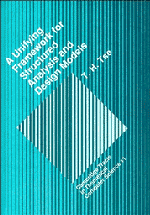 A Unifying Framework for Structured Analysis and Design Models
A Unifying Framework for Structured Analysis and Design Models Book contents
- Frontmatter
- Contents
- Preface
- List of Tables and Figures
- Chapter 1 Introduction
- Chapter 2 Desirable Features of Systems Development Environments
- Chapter 3 A Comparison with Related Work
- Chapter 4 An Initial Algebra Framework for Unifying the Structured Models
- Chapter 5 A Functorial Framework for Unifying the Structured Models
- Chapter 6 The Identification of Unstructuredness
- Chapter 7 A Prototype System to Implement the Unifying Framework
- Chapter 8 Conclusion
- Bibliography
- Index
Chapter 4 - An Initial Algebra Framework for Unifying the Structured Models
Published online by Cambridge University Press: 28 January 2010
- Frontmatter
- Contents
- Preface
- List of Tables and Figures
- Chapter 1 Introduction
- Chapter 2 Desirable Features of Systems Development Environments
- Chapter 3 A Comparison with Related Work
- Chapter 4 An Initial Algebra Framework for Unifying the Structured Models
- Chapter 5 A Functorial Framework for Unifying the Structured Models
- Chapter 6 The Identification of Unstructuredness
- Chapter 7 A Prototype System to Implement the Unifying Framework
- Chapter 8 Conclusion
- Bibliography
- Index
Summary
INTRODUCTION
Chapters 4 and 5 describe a unifying framework for the structured systems development models. Such a framework is useful for several reasons:
(a) Many projects to provide theoretical support for systems development do not use the popular structured analysis and design models. As pointed out in Davis (1982) and Martin (1983, 1984), practitioners are rather hesitant to use new tools that involve an unfamiliar formal language. On the other hand, a unifying theoretical framework that adds formal components to the notations of structured specifications permits users to continue using existing popular practices.
(b) Different structured models are suitable for different situations, depending on the characteristics of user requirements, the emphasis and the stage of development (Colter 1982, Lauber 1982, Sanden 1989, Shigo et al. 1980). In other words, we may need more than one of these tools during the development process of a single system. If we provide systems developers with a means of mapping from one model to another, the efficiency of systems development may be greatly improved.
(c) A number of development aids have been designed for individual structured models (Delisle et al. 1982, DeMarco and Soceneantu 1984, Kampen 1982, Tse 1985, Tse and Pong 1989). However, these aids are useful only for individual models, and are not applicable to others. If a mapping can be found to transform one model to another, a development aid for one structured methodology may be applied to another.
[…]
Information
- Type
- Chapter
- Information
- A Unifying Framework for Structured Analysis and Design ModelsAn Approach Using Initial Algebra Semantics and Category Theory, pp. 35 - 69Publisher: Cambridge University PressPrint publication year: 1991